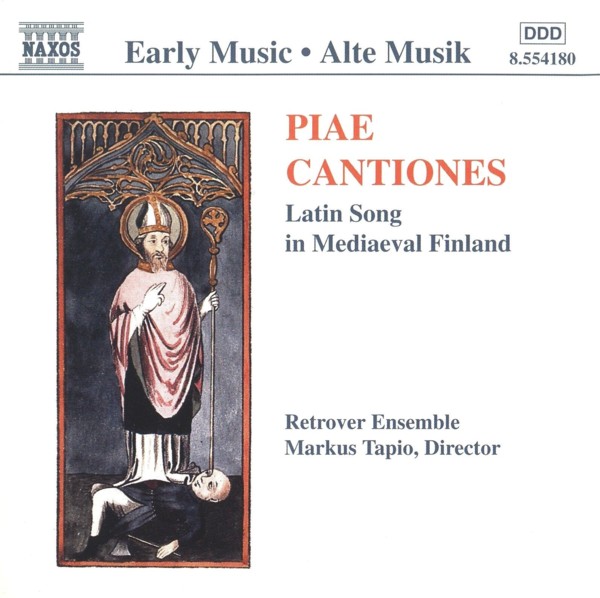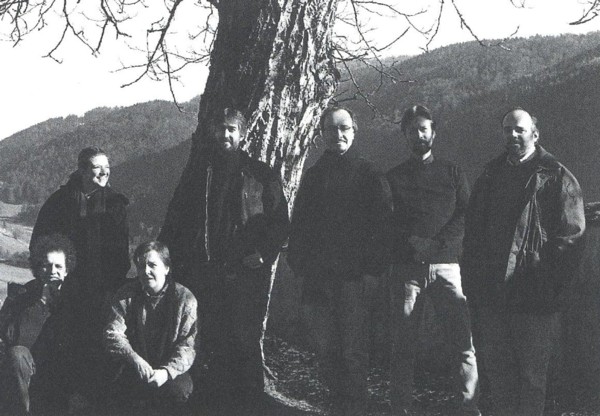Piae Cantiones. Latin Song in Mediaeval Finland / Retrover Ensemble

medieval.org
Naxos "Early Music" 8.554180
Sornetan Church, Suiza
febrero de 1997
Piae Cantiones 1582
Latin Song in Mediaeval Finland
01 - Praeambulum [improv. sobre El Llibre Vermell]
instr. [2:32]
02 - Angelus emittitur [2:24]
03 - Parvulus nobis nascitur [PC 1625 · Jacob
OBRECHT?] [2:30]
04 - Ramus virens olivarum [4:29]
05 - Dies est laetitiae [2:52]
06 - Omnis mundus jucundetur [2:27]
07 - Mirum si laeteris (instr.) [3:40]
08 - Sum in aliena provincia [3:59]
09 - Mars praecurrit in planetis [1:28]
10 - Jesus Christus nostra salus [PC 1582 · Leipzig UB
1084] instr. [2:32]
11 - Jucundare jugiter [1:42]
12 - Omnis nunc microcosmus ~ Omnis mundus [Codex
Speciálníc] [2:18]
13 - Jesu dulcis memoria [3:20]
14 - Dies est laetitiae [Glogauer Liederbuch] instr.
[2:45]
15 - Verbum caro factum est [3:18]
16 - Verbum caro factum est [Cancionero de Uppsala]
[1:09]
17 - Personent hodie ~ Gaudete, gaudete, Christus est natus
[2:56]
18 - Dies est laetitiae [Adam von FULDA] [2:17]
19 - Puer natus in Bethlehem [PC 1625] [4:58]
20 - Aetas carmen melodiae [1:22]
21 - Dies est leticie [Buxheimer Orgelbuch] instr.
[2:19]
22 - Surrexit Christus hodie [Johann Hermann SCHEIN]
[2:08]
23 - Aetas carmen melodiae [PC 1625 · Daniel
FREDERICI] [2:45]
[entre corchetes las fuentes de las obras no tomadas de las Piae Cantiones de 1582]
RETROVER ENSEMBLE
Markus Tapio
María Cristina Kiehr, soprano
Eric Mentzel, tenor
Eitan Sorek, tenor
Stephen Grant, bass
Markus Tapio, viola da gamba, vielle
Jankes Braaksma, organetto, recorder
Agileu Motta, lute
Leena Joutsenlahti, kantele, recorder

Piae Cantiones
Latin Song in Mediaeval Finland
One early but ill fated attempt to create a Greater Northern Union of
states in Scandinavia was made in 1397, when all Nordic countries were
to be brought under Danish rule. The Union of Kalmar finally fell apart
in 1523 after repeated Swedish rebellions. This ultimate dissolution
was preceded by the famous Stockholm massacre in which 82 noblemen and
clergy who supported Swedish independence were executed by the Danes.
The leader of the successful Swedish uprising was Gustavus Vasa who
then became king of Sweden and its eastern duchy, Finland. It was not,
however, solely bravery and national patriotism that secured victory.
Mercenaries were expensive and warfare in the sixteenth century
typically included a provider of capital with commercial interests, in
this case the Hanseatic merchants of Lübeck. In consequence the
war left Gustavus Vasa seriously in debt. This has often been
considered one reason why Sweden and Finland so quickly adopted the new
Protestant religious doctrines. According to these, the head of the
state was also head of the national church. This, in turn, translated
into the right of the crown to confiscate church property.
In Sweden the whole Reformation was accomplished without much conflict
or bloodshed and this was even more the case in Finland, which with its
own diocese in Turku (Latin Aboa) had enjoyed a large measure
of religious independence since the fourteenth century. The first
Finnish hymnal, published in 1583 by Jaakko Firmo, headmaster of Turku
Cathedral School, notably lacks the militant combat songs so typical of
many other contemporary hymnals.
Together with Theodoricus Petri, a Finnish student at the University of
Rostock, Jaakko Finno was also the principal editor of a curious
collection of Latin devotional songs for the schola Aboensi in
Finlandia, published in Greifswald in 1582. This book, under the
title Piae Cantiones ecclesiasticae et scholasticae veterum
episcoporum, contains music of extensive chronological and
geographical scope. Stylistically the content is clearly older than the
publishing date might suggest and some compositions can be traced back
to the turn of the millennium. The main body of compositions, however,
can be placed within the fifteenth-century Germanic-Bohemian Cantio
tradition.
The question arises as to why a book such as Piae Cantiones
should have been produced in Protestant Finland by a clergyman who on
another occasion had called the use of Latin in the liturgy a Devil's
invention and why it should have been published in continental Europe
and not, for instance in Stockholm, the capital. It seems that the
impulse for this book came directly from King Johan III of Sweden, who
had strong Catholic sympathies and, as a former governor and Duke of
Finland, was well acquainted with its cultural heritage. As the title
of the book suggests, it seems that Piae Cantiones, rather than
being a coherent musical entity, is an attempt to salvage a centuries
old local musical tradition doomed to obsolescence. This character of
the collection is apparent from the lack of any contemporary musical
material and the manner of presentation of the compositions, suggesting
a strong oral element in their transmission. The place of publication
can probably be explained by the continuing presence of Finnish
students at the Catholic universities of Central Europe and the
stronger anti-Catholic sentiments of Sweden itself.
Piae Cantiones did not completely escape theological
controversy. Some of its texts were 'corrected' by Jaakko Finno, a task
carried out rather superficially, generally simply by replacing words
such as Maria and Virgo by words such as Christus
and Puer, and so on. Naturally, this often resulted in a
violation of the poetic structure and, in a couple of cases, in
complete nonsense, as, for instance, when Christus was assigned the
virginal attribute porta clausa nec pervia.
The second edition of Piae Cantiones was published in 1625 in
Rostock and is connected in many ways with the other main mediaeval
centre of Finland, Viborg. This time a well known German church
musician Daniel Friderici served as an artistic director of the
enterprise. Sensing the historical and cultural value of the
collection, he preserved all the monophonic songs of the first edition.
Many of the three-part polyphonic compositions, however, he replaced by
music reflecting contemporary taste. In this respect, the second
edition has more the character of a practical song-book. Few
sixteenth-century musical collections anywhere in Europe enjoy such an
established position in today's musical life as Piae Cantiones
in Finland. In the wake of early twentieth-century national romanticism
a whole mixed choir tradition has evolved around these melodies, some
of which are also represented in the church hymnal. As a result, one
concept hardly ever applied to this repertory in Finland is that of
so-called historical performance practice. Similarly, the emphasis on
elements of national origin, of which there are many, has largely
hindered the public from seeing this collection in its proper context
as a large and coherent body of strophic Latin non-liturgical song,
ranging in provenance from the Mediterranean to the Baltic.
In the present recording our intention has been to explore these links
that connect Finland with the common musical heritage of Europe. Some
compositions, therefore, are taken from sources other than the Piae
Cantiones collection itself. A remarkable number of the Piae
Cantiones songs, however, are not found in other sources and their
origins are subject to speculation. Many of them are likely to be
Finnish, such as Ramus virens olivarum, a hymn to St Henry, an
English bishop who was axed down by an uncooperative native on the ice
of Lake Köyliö in 1155, a fate for which, as compensation, he
later became the patron saint of Finland. Another curious composition
is Aetas carmen melodiae, which in the 1625 edition is replaced
by a song of Daniel Friderici himself. In spite of its archaic beauty,
the counterpoint of the original three-voice version is downright
bizarre and could well be the local product of a less than pedantic
composer. Of the compositions which have known Central European
connections, most are of German or Bohemian origin, or at least
transmitted through that area. A good example of this is Dies est
laetitiae, which appears in fifteenth and sixteenth century sources
in countless variations and later as a Lutheran chorale with the text Der
Tag der ist so freudenreich. The melody of Parvulus nobis
nascitur is of German popular origin and preserved, for instance,
in the Glogauer Liederbuch with a vernacular text. The present
polyphonic version is thought to be by the Flemish master Jacob Obrecht
and is taken from the first printed volume of polyphonic music,
Ottaviano Petrucci's Odhecaton (Venice 1501). Many of the older
Piae Cantiones songs have their origins further south. For
instance, the earliest known provenance for Verbum caro factum est
is in a French manuscript dating from before the year 1100. This song,
which might have travelled to Finland with Finnish students from Paris
University, can also be found in some Italian and Spanish sources. In
the same twelfth-century Spanish manuscript there is also a version of Omnis
mundus jucundetur. In this recording this composition will appear
twice, first in the monophonic Piae Cantiones version and then
as a double-text motet from the Czech Speciednik manuscript. Puer
natus in Bethlehem, well known in the Germanic part of Europe, has
its earliest known source from the monastery of Bobbio in Italy.
Our knowledge of musical performance practice in mediaeval Finland is
virtually non-existent. Since the main cultural exchange between
Finland and other countries took place through active trade with other
Baltic states and the Hanseatic League, we have looked to German
instrumental practice of the fifteenth century for inspiration. The use
of the kantele, the traditional Finnish psaltery, in some
compositions allows us to explore hypothetical links between the
scholarly musical world and folk-tradition.
Markus Tapio

